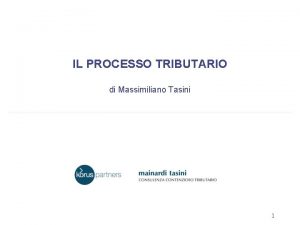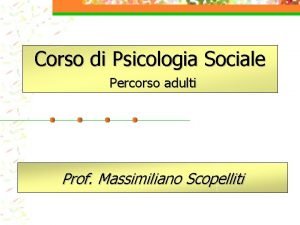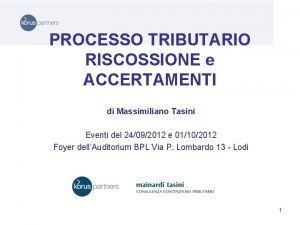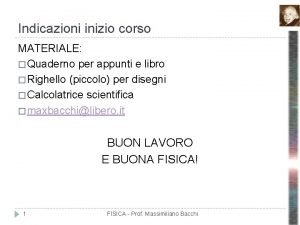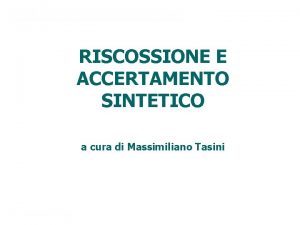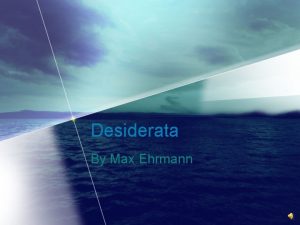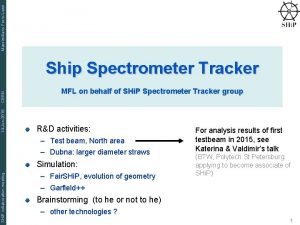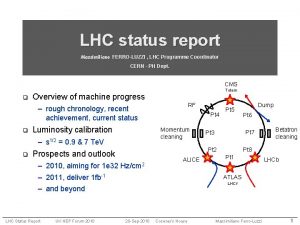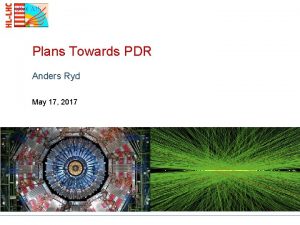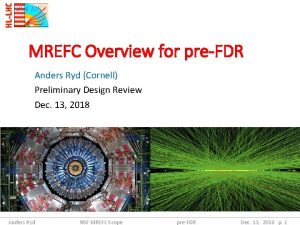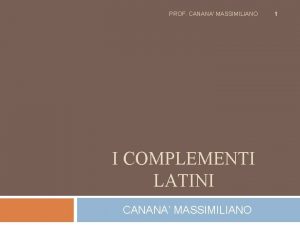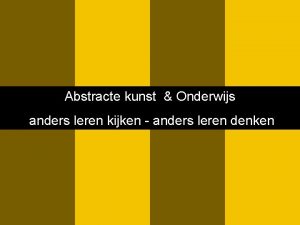Experiments desiderata Anders Ryd for Massimiliano FerroLuzzi on
















- Slides: 16

Experiments desiderata Anders Ryd for Massimiliano Ferro-Luzzi on behalf of the LHC Experiments Experimentns desiderata where we stand, what we wish luminosity / pile-up requirements, other parameters projections special physics requests 15 -July-2011 'mini-Chamonix' Anders Ryd 1

One of these silly slides shown at Chamonix 2011 Experimentns desiderata 15 -July-2011 'mini-Chamonix' Anders Ryd 2

And now it looks like this Suppose: Lstart = 4. 5 e 32 Lyeah = ~1. 2 e 33 Lyeswecan! = 2 e 33 124 days high lumi physics days – 35% of that in stable beams, decay factor 0. 7 144 high lumi physics days o ATLAS/CMS ~1. 3 fb-1 at ~25 pb-1/day 80 more days ? high lumi physics days Experimentns desiderata 15 -July-2011 28 pb-1 collected before the scrubbing, 2 weeks at 75 ns 'mini-Chamonix' Anders Ryd 3

Physics Reach 120 ATLAS + CMS 95% CL exclusion 3 sensitivity 5 sensitivity 1 fb-1 120 - 530 135 - 475 152 - 175 2 fb-1 114 - 585 120 - 545 140 - 200 5 fb-1 114 - 600 128 - 482 10 fb-1 114 - 600 117 - 535 LHCb will probe the standard model range with 1 fb-1 in Bs→ + -. Experimentns desiderata 15 -July-2011 'mini-Chamonix' Anders Ryd 4

LHCb Leveling is a success: gives an extra factor 1. 4 on integrated lumi LHCb working hard to push upward the working point – Operated at 3 e 32 Hz/cm 2 in June, tested up to 4 e 32 Hz/cm 2 and will run at 3. 5 e 32 Hz/cm 2 this summer – NEED LARGEST POSSIBLE NR OF COLLIDING PAIRS increasing nr (to keep pile-up under control) of bunches – NEED LARGEST NR OF HOURS Status: ~0. 4 fb-1 , 9 pb-1 / day Exceeding the 2011 target of 1 fb-1 remains a challenge, though a sensible one. high lumi physics days Experimentns desiderata 15 -July-2011 'mini-Chamonix' Anders Ryd 5

The rule of thumb 9. 3 h/day 8. 2 h/day TS 1 Scrub 7. 8 h/day MD 1 TS 2 1 day of physics operation for 8 h of stable beams Experimentns desiderata 15 -July-2011 'mini-Chamonix' Anders Ryd 6

Wishes-to-expectations conformal theory From the previous slide, everybody think now that (with 90 more days of high luminosity physics, see later) 4 fb-1 delivered to IP 1 and IP 5 each 1 fb-1 delivered to IP 8 are realistic wishes (and even more seems achievable!). Thus, any change (improvement) of LHC operation should be considered in the light of these (now realistic) integrated luminosity expectations for 2011. Setup time to be balanced with gain in integrated lumi. Experimentns desiderata 15 -July-2011 'mini-Chamonix' Anders Ryd 7

pp physics operation: 101 days Post-TS ramp up: 2 x 2. 5 days 90 days of high lumi operation Special physics: Experimentns desiderata 15 -July-2011 6 days ? 'mini-Chamonix' -2 days of floating MD ? Anders Ryd 8

Wishes from experiments: luminosity / pile-up In general: – Maximum integrated luminosity Lint – For same integrated luminosity, prefer less pile-up ATLAS / CMS: we assume that µ increases gradually (not in one step) – Main aim: maximize Lint, push instantaneous luminosity, but without compromising high machine efficiency – An extended physics period up to 3 e 33 before further increase seems like a reasonable strategy µ = average number of inelastic interactions per bunch crossing – Pile-up: might become a challenge when µ > 25 (now = ~7 in IP 1/5) • Want to explore highest possible PU at end of run LHCb: – Maximize Lint , i. e. maximize running time – Instantaneous luminosity: run at fixed value, ~3. 5 e 32 Hz/cm 2 , no luminosity decay, continue with leveling (great, so far !) – Pile-up: µ < 2. 5 ALICE: – Maximize Lint , i. e. maximize running time – Instantaneous luminosity: 5 e 29. . . 5 e 30 Hz/cm 2 , but – Pile-up: µ < 0. 05 Experimentns desiderata 15 -July-2011 'mini-Chamonix' Anders Ryd 9

Special physics activities 90 m third fill 90 m n x physics fill machine-available time => around Sep TS 4/MD 3 ~8 h => TBD n x ~8 h TOTEM/RPs 147 m ALICE field reversal precise lumi calib 25 ns physics fill => not before Sep TS 4 => not before end of Sep ~8 h ~16 h 2 x ~8 h Remember the rule of thumb: 8 h of m. a. time = 1 real day of operation Some of these will have to be dropped / reduced Experimentns desiderata 15 -July-2011 'mini-Chamonix' Anders Ryd 10

Integrated luminosity: what will you push ? frev kb N 2 L 0 = 4 * T Times: pr=preparation sb=stable beams hlp=high lumi physics T -t / sb ) L = L(t)dt L 0 (1 -ehlp tpr+tsb Physics time and kb: these do not increase pile-up While N, * and T all do increase pile-up Increasing N: fairly small setup time ? (adiabatic changes) Reducing T : fairly small setup time ? (adiabatic changes) Reducing * : how much setup time ? – Gain in peak lumi to be balanced with commissioning time => int. Lumi L – Perhaps profitable for next year's planning and perhaps for 2011 ion run – For LHCb: no gain from smaller *, can only give a loss => 1 fb-1 in danger ? kb => 25 ns: how much setup time ? – 25 ns operation is profitable for all expts, if can achieve same L – Lumi production at 25 ns for this year seems inadequate estimate for scrubbing time? some experiments might need time to adapt? – Expts wish for at least one stable beams fill, but toward end of run prepare for possible use of 25 ns during next year's physics production Experimentns desiderata 15 -July-2011 'mini-Chamonix' Anders Ryd 11

In Summary LHC routinely operated at >1 e 33 machine since mid May 2011 goals for IP 1/5 already achieved! 8 h stable beams per day (room for improvement ? ) Prospects for >1 fb-1 at IP 8 and >4 fb-1 at IP 1/5 look very good The experiments would favour increasing the luminosity by those means which have the least cost in hours of stable beams This probably means: Maximize physics operation time (machine availability) Reduce T (50 ns double batch. . . ) Increase bunch charge Reducing * and increasing kb (25 ns): keep it "exploratory" in view of 2012 and ion run, to be carefully balanced with impact on integrated luminosity Experimentns desiderata 15 -July-2011 'mini-Chamonix' Anders Ryd 12

Backup Experimentns desiderata 15 -July-2011 'mini-Chamonix' Anders Ryd 13

(1 ns 1. 5 ns ? ? ) Bunch length increase ? Possible benefits for machine performance: – less resistive losses (cryo, kicker, collimators ? ) – less intra-bunch scattering (compensate for decrease in T ) For the experiments? – reduction in acceptance ? – better separation of vertices ? Experimentns desiderata 15 -July-2011 'mini-Chamonix' Anders Ryd 14

Ions in 2011 Had no time to discuss Will pick this up at mid August p-A test in 2011 is much welcome (for physics in subsequent ion run) LHCb is discussing presently to run during ions (few colliding pairs). Experimentns desiderata 15 -July-2011 'mini-Chamonix' Anders Ryd 15

Post-TS intensity ramp up How will the LHC reach previously established maximum luminosity after a technical stop ? From r. MPP 28. 06. 2011: – test ramp with a pilot – physics fill with 2 x 2 nominal bunches also loss maps ? – – physics fill with ~50 nominal bunches physics fill with ~260 nominal bunches physics fill with ~850 nominal bunches back to 1380 bunches Experimentns desiderata 15 -July-2011 'mini-Chamonix' Total: ~4 x 5 h of machine-available time, i. e. 2. 5 days of operation These can all be short (1 -3 h stable beams for the expts to collect some data and check out the detectors ? ) Anders Ryd 16
 Anders ryd
Anders ryd Massimiliano tasini
Massimiliano tasini Massimiliano scopelliti
Massimiliano scopelliti Massimiliano tasini
Massimiliano tasini Rak massimiliano
Rak massimiliano Massimiliano mascherini
Massimiliano mascherini Massimiliano bacchi
Massimiliano bacchi Massimiliano ferro
Massimiliano ferro Massimiliano marzocca
Massimiliano marzocca Massimiliano marzocca
Massimiliano marzocca Massimiliano stramaglia
Massimiliano stramaglia Urologia fatebenefratelli napoli
Urologia fatebenefratelli napoli Massimiliano dragoni
Massimiliano dragoni Massimiliano marzocca
Massimiliano marzocca Massimiliano madonna
Massimiliano madonna Massimiliano pellegrini
Massimiliano pellegrini Desiderata by max
Desiderata by max

